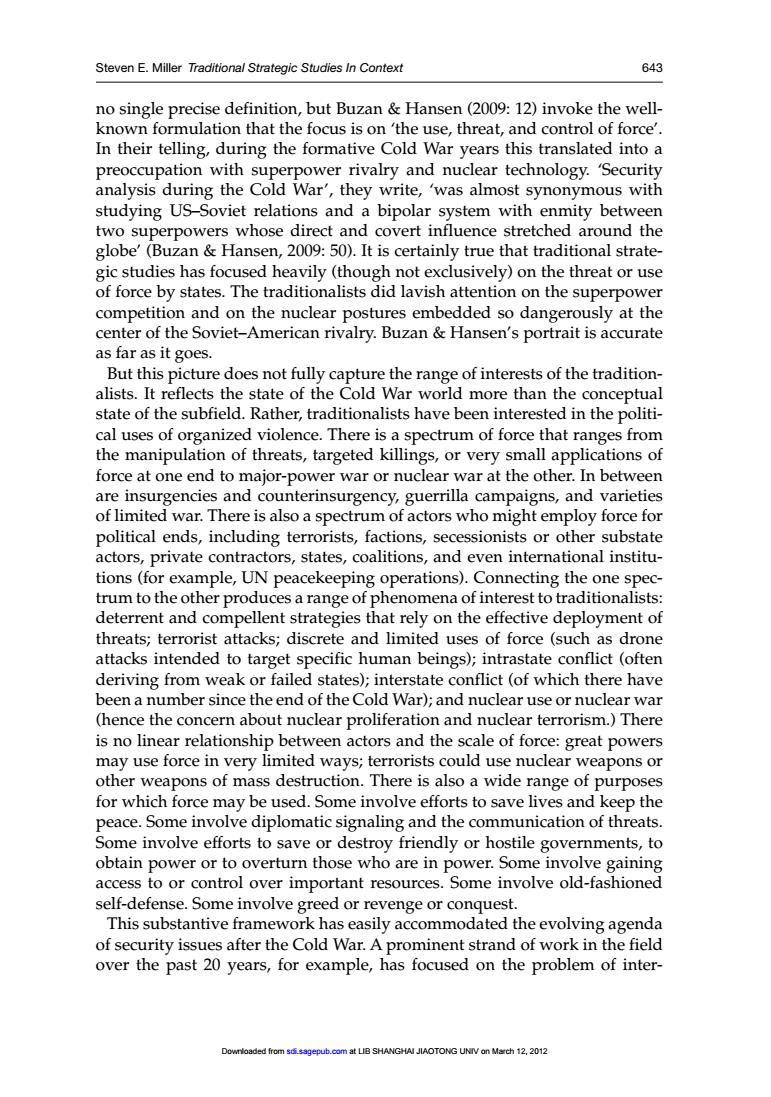正在加载图片...

Steven E.Miller Traditional Strategic Studies In Context 643 no single precise definition,but Buzan Hansen (2009:12)invoke the well- known formulation that the focus is on 'the use,threat,and control of force'. In their telling,during the formative Cold War years this translated into a preoccupation with superpower rivalry and nuclear technology.Security analysis during the Cold War',they write,'was almost synonymous with studying US-Soviet relations and a bipolar system with enmity between two superpowers whose direct and covert influence stretched around the globe'(Buzan Hansen,2009:50).It is certainly true that traditional strate- gic studies has focused heavily(though not exclusively)on the threat or use of force by states.The traditionalists did lavish attention on the superpower competition and on the nuclear postures embedded so dangerously at the center of the Soviet-American rivalry.Buzan Hansen's portrait is accurate as far as it goes. But this picture does not fully capture the range of interests of the tradition- alists.It reflects the state of the Cold War world more than the conceptual state of the subfield.Rather,traditionalists have been interested in the politi- cal uses of organized violence.There is a spectrum of force that ranges from the manipulation of threats,targeted killings,or very small applications of force at one end to major-power war or nuclear war at the other.In between are insurgencies and counterinsurgency,guerrilla campaigns,and varieties of limited war.There is also a spectrum of actors who might employ force for political ends,including terrorists,factions,secessionists or other substate actors,private contractors,states,coalitions,and even international institu- tions(for example,UN peacekeeping operations).Connecting the one spec- trum to the other produces a range of phenomena of interest to traditionalists: deterrent and compellent strategies that rely on the effective deployment of threats;terrorist attacks;discrete and limited uses of force(such as drone attacks intended to target specific human beings);intrastate conflict (often deriving from weak or failed states);interstate conflict (of which there have been a number since the end of the Cold War);and nuclear use or nuclear war (hence the concern about nuclear proliferation and nuclear terrorism.)There is no linear relationship between actors and the scale of force:great powers may use force in very limited ways;terrorists could use nuclear weapons or other weapons of mass destruction.There is also a wide range of purposes for which force may be used.Some involve efforts to save lives and keep the peace.Some involve diplomatic signaling and the communication of threats. Some involve efforts to save or destroy friendly or hostile governments,to obtain power or to overturn those who are in power.Some involve gaining access to or control over important resources.Some involve old-fashioned self-defense.Some involve greed or revenge or conquest. This substantive framework has easily accommodated the evolving agenda of security issues after the Cold War.A prominent strand of work in the field over the past 20 years,for example,has focused on the problem of inter- Downloaded from sdi.sagepub.com at LIB SHANGHAI JIAOTONG UNIV on March 12,2012Steven E. Miller Traditional Strategic Studies In Context 643 no single precise definition, but Buzan & Hansen (2009: 12) invoke the wellknown formulation that the focus is on ‘the use, threat, and control of force’. In their telling, during the formative Cold War years this translated into a preoccupation with superpower rivalry and nuclear technology. ‘Security analysis during the Cold War’, they write, ‘was almost synonymous with studying US–Soviet relations and a bipolar system with enmity between two superpowers whose direct and covert influence stretched around the globe’ (Buzan & Hansen, 2009: 50). It is certainly true that traditional strategic studies has focused heavily (though not exclusively) on the threat or use of force by states. The traditionalists did lavish attention on the superpower competition and on the nuclear postures embedded so dangerously at the center of the Soviet–American rivalry. Buzan & Hansen’s portrait is accurate as far as it goes. But this picture does not fully capture the range of interests of the traditionalists. It reflects the state of the Cold War world more than the conceptual state of the subfield. Rather, traditionalists have been interested in the political uses of organized violence. There is a spectrum of force that ranges from the manipulation of threats, targeted killings, or very small applications of force at one end to major-power war or nuclear war at the other. In between are insurgencies and counterinsurgency, guerrilla campaigns, and varieties of limited war. There is also a spectrum of actors who might employ force for political ends, including terrorists, factions, secessionists or other substate actors, private contractors, states, coalitions, and even international institutions (for example, UN peacekeeping operations). Connecting the one spectrum to the other produces a range of phenomena of interest to traditionalists: deterrent and compellent strategies that rely on the effective deployment of threats; terrorist attacks; discrete and limited uses of force (such as drone attacks intended to target specific human beings); intrastate conflict (often deriving from weak or failed states); interstate conflict (of which there have been a number since the end of the Cold War); and nuclear use or nuclear war (hence the concern about nuclear proliferation and nuclear terrorism.) There is no linear relationship between actors and the scale of force: great powers may use force in very limited ways; terrorists could use nuclear weapons or other weapons of mass destruction. There is also a wide range of purposes for which force may be used. Some involve efforts to save lives and keep the peace. Some involve diplomatic signaling and the communication of threats. Some involve efforts to save or destroy friendly or hostile governments, to obtain power or to overturn those who are in power. Some involve gaining access to or control over important resources. Some involve old-fashioned self-defense. Some involve greed or revenge or conquest. This substantive framework has easily accommodated the evolving agenda of security issues after the Cold War. A prominent strand of work in the field over the past 20 years, for example, has focused on the problem of interDownloaded from sdi.sagepub.com at LIB SHANGHAI JIAOTONG UNIV on March 12, 2012